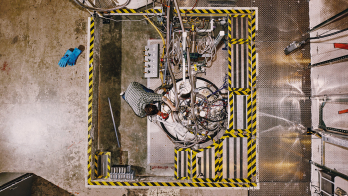The four detector groups conducting research at the Relativistic Heavy Ion Collider (RHIC) at the Brookhaven National Laboratory have announced results indicating that they have observed a state of hot, dense matter that is more remarkable than had been predicted. In papers summarizing the first three years of RHIC findings, to be published simultaneously by the journal Nuclear Physics A, the four collaborations (BRAHMS, PHENIX, PHOBOS and STAR) say that instead of behaving like a gas of free quarks and gluons, as was expected, the matter created in RHIC’s heavy-ion collisions appears to be more like a liquid.
The evidence comes from measurements of unexpected patterns in the trajectories of the thousands of particles produced in individual collisions. The primordial particles produced tend to move collectively in response to variations of pressure across the volume formed by the colliding nuclei – an effect known as “flow”, since it is analogous to the properties of fluid motion.
However, unlike ordinary liquids, in which individual molecules move about randomly, the hot matter at RHIC seems to move in a pattern exhibiting a high degree of coordination among the particles.
This flow is consistent with that of a theoretically “perfect” fluid with extremely low viscosity and the ability to reach thermal equilibrium very rapidly because of the high degree of interaction among the particles. The physicists at RHIC do not have a direct measure of the viscosity, but they can infer from the flow pattern that, qualitatively, the viscosity is very low, approaching the quantum mechanical limit.








